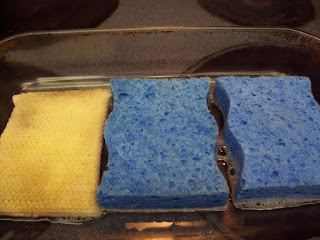 |
| Almost a tablespoon of ginger in the bottom of the bag! |
I've been wanting to try making it again as I have been eating a lot of crystallized ginger (I like the taste and it satisfies my sweet tooth in the evenings). I recently saw Daphne Oz (Dr. Oz's daughter) on The Chew and she made candied citrus peel. The segment was real quick, no real demonstration, but her explanation was so easy, I decided to try it with ginger - and it worked. I am very pleased with how it turned out.
Here is how I did it. I bought a huge chunk of ginger root - it was $3.99 a pound and I had just under a pound (sorry, I didn't get a pic of that huge root before I cut it up). Make sure the ginger you buy is not wrinkly and soft (that means it's old) - the one I bought was firm and thick.
I cut it up in manageable pieces and used the edge of a large spoon to scrape off the skin (which is not edible). I tried using a vegetable peeler, but it took off too much ginger, so I stuck with using the spoon. **Update** I figured out that if you peel the ginger like a potato - use a small spoon and flick the skin away from you, into a sink that has a trap to catch all the peel, the peeling process goes a lot faster. If you use more wrist action, you will have less wear on your fingers and joints.


All peeled and ready to be sliced. The peelings are thin and do make a mess.
This is what I used to get even slices. If you don't have a slicer, you can use a sharp knife and cut into thin slices.
I started out using this large skillet. I put in 2 cups of filtered water and 1 1/2 cups of sugar. Your basic simple syrup recipe is 1 cup sugar to 1 cup water - I wanted less sugar.
After the sugar dissolved, I decided that the cooking surface area was too large, so I dumped the sugar mixture into a large sauce pan. I added the ginger and mixed everything. I set my timer for 2 hours. **Update** I have since updated this whole process - check it out here.
In the middle of the cooking time, I decided to strain out the bits of peel, so I alternated between the large skillet and sauce pan to strain the sugar syrup (I have a metal tea strainer, which worked great for this).
After 2 hours, I put the candied ginger into a large strainer to remove the excess sugar syrup.
I put the ginger onto a foil lined cookie sheet and sprinkled about a tablespoon of sugar on top. I wet my hands (so nothing would stick) and coated the ginger with the sugar.
I placed the ginger pieces onto a cooling rack, some went directly on the foil, to set up.
There was hardly any sugar left on the bottom of the cookie sheet after all the sugar was coated on the ginger.
If perchance your ginger is "wet" and sticks together, place your slices on a cookie sheet in a single layer and bake at 200 degrees for 1 hour. Your ginger should not clump up when done - a few that stick together is ok.
The taste is really good, you get that ginger bite you expect from ginger, unlike the store bought kind where you taste more sugar and less ginger. I really like it and plan to never buy crystallized ginger from a store again. Oh, and the leftover ginger sugar syrup . . . I plan to use it the next time I make turmeric milk.
Please give this a try I really think you'll like it as much as I do.
If perchance your ginger is "wet" and sticks together, place your slices on a cookie sheet in a single layer and bake at 200 degrees for 1 hour. Your ginger should not clump up when done - a few that stick together is ok.
The taste is really good, you get that ginger bite you expect from ginger, unlike the store bought kind where you taste more sugar and less ginger. I really like it and plan to never buy crystallized ginger from a store again. Oh, and the leftover ginger sugar syrup . . . I plan to use it the next time I make turmeric milk.
Please give this a try I really think you'll like it as much as I do.
Ginger simple syrup
Thanks for reading!!
Comments or questions are always welcomed. I would love to hear what you think of this recipe or any of my other posts. Thanks!





















